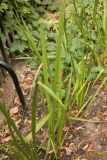Additional notes (click to expand)
Medicinal
Culpeper: ‘I shall not, nor dare not make a long paraphrase about the sorts of it, one of which is Water-Flag or flower-de-Luce, which ... binds, strengthens, stops fluxes of the belly, and immoderate flowing of the terms in women, a drachm being taken in red wine every morning.’
Culpeper, Nicholas. (1650). A Physical Directory . London, Peter Cole.
One study in 1995 showed Acorus calamus was effective in reducing depression and improving rehabilitation.
Gupta, A.K. (2004). Indian Medicinal Plants. Volume 1 (Abe-Alle. Indian Council of Medical Research, New Delhi. P.212
Dried rhizome used in ayurvedic medicine for epilepsy, schizophrenia, constipation, colic, cough, asthma, memory loss in powder, balm, enema, pill or ghee form.
Gupta, A.K. (2004). Indian Medicinal Plants. Volume 1 (Abe-Alle. Indian Council of Medical Research, New Delhi. p. 195
In South African herbal medicine it is used to treat diarrhoea. The powdered root used to be used to clean teeth. - but see Toxicity.
Van Wyk, B.E., Van Oudtshoorn, B Gericke, N. (2000). Medicinal Plants of South Africa, Briza Publications. 2nd ed
Other use
A source of calamus oil used in perfume.
Gupta, A.K. (2004). Indian Medicinal Plants. Volume 1 (Abe-Alle. Indian Council of Medical Research, New Delhi. p.195
Toxicity
Oil of calamus contains beta-asarone which is carcinogenic, nephrotoxic and causes convulsions (MCA, 2002). It should not be taken internally and its use has been banned in most countries.
Medicines and Health Care Regulatory Agency , MCA. (2002). Medicines and Health Care Regulatory Agency (MHRA) for restricted or prohibited herbal medicines. Medicines and Health Care Regulatory Agency .
link
Contains beta-asarone which is carcinogenic, and possibly genotoxic. Leiomyosarcomas formed in the small intestines of rats fed beta-asarone for 2 years. Hepatomas formed in pre-weaning mice. Genotoxicity studies were equivocal but the recommendations are that it should be regarded as genotoxic (EU-SCF).
van den Berg, S.J.P.L., Restani, et al., P.. (2011). Levels of Genotoxic and Carcinogenic Compounds in Plant Food Supplements and Associated Risk Assessment. Food and Nutrition Science 2: 989-1010.
link
The tetraploid form of Acorus calamus should be placed in category 6, i.e. the plant is considered as
unfit for human consumption in any amounts.
European Commission SCF/CS/FLAV/FLAVOUR/9 ADD1 Final
Geographical distribution
- Asia-Temperate, Caucasus, Transcaucasus
- Asia-Temperate, China
- Asia-Temperate, Eastern Asia, Japan
- Asia-Temperate, Eastern Asia, Korea
- Asia-Temperate, Mongolia
- Asia-Temperate, Russian Far East
- Asia-Temperate, Siberia
- Asia-Temperate, Western Asia, Afghanistan
- Asia-Temperate, Western Asia, Iran
- Asia-Temperate, Western Asia, Turkey
- Asia-Tropical, Indian Subcontinent, Bangladesh
- Asia-Tropical, Indian Subcontinent, East Himalaya
- Asia-Tropical, Indian Subcontinent, India
- Asia-Tropical, Indian Subcontinent, Nepal
- Asia-Tropical, Indian Subcontinent, Pakistan
- Asia-Tropical, Indian Subcontinent, Sri Lanka
- Asia-Tropical, Indo-China, Thailand
- Asia-Tropical, Indo-China, Vietnam
- Asia-Tropical, Malesia
Acorus calamus L.
Family: ACORACEAEGenus: Acorus
Species: calamus L.
Common names: Sweet Flag
Pharmacopoeia Londinensis name: Calamus aromaticus
Distribution summary: Asia
Habit: Perennial
Hardiness: H5 - Hardy; cold winter
Habitat: Marshy, semi-aquatic areas to 2200 m
Garden status: Currently grown
Garden location: Pharmacopoeia Londinensis 1618 'Roots' (HSE 3), Pharmacopoeia Londinensis 1618 'Roots' (HSE 2B)
Reason for growing: Medicinal, toxic
